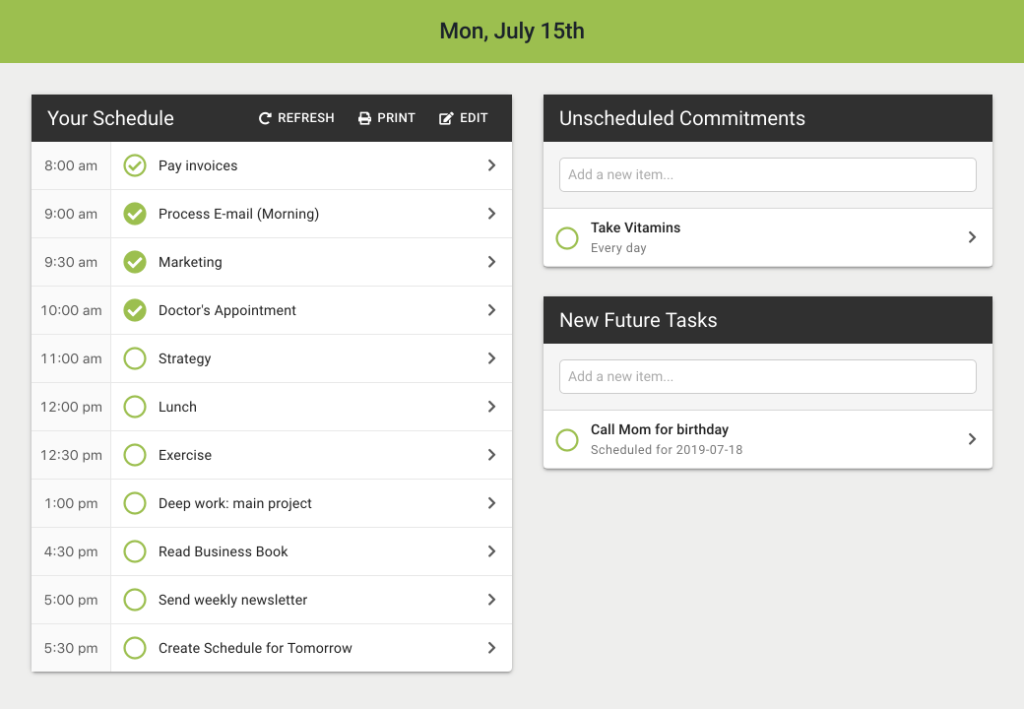Many productivity systems use the concept of a Most Important Task–the task that is most critical to helping you achieve your goals.
While I think Most Important Tasks (MITs) can be powerful, they can also be challenging. How do you determine exactly what is your Most Important Task? Can you just pick one of the tasks on your task list, or should it be a task you specifically create? How do you know what a “good” MIT is? Can you have more than one Most Important Task?
Analysis Paralysis & Decision Fatigue
One of the problems with Most Important Tasks is that they create analysis paralysis and decision fatigue. People can’t quickly decide which task is their MOST important task, so they pick two or three. Or they start off strong, but then tire of deciding each day which task is most important and lose the habit.
Part of this can be solved by taking the time once a week to determine your MITs for each day of the week. On Sunday night, sit down and write each day of the week in a column on a sheet of paper, and then next to each day, write the ONE thing that is most important to achieving your current goal, that you plan to do that day.
To help stay focused, write your current goal at the top of the page, so you can ask whether each MIT you write down truly helps you toward that goal.
Developing a MIT Strategy
You can make the process easier by choosing a strategy that supports your goal. Use this strategy to determine what your Most Important Tasks should look like. A strategy helps you select your MITs from your existing tasks or recognize when you need to create new MITs to better move toward your goal.
A strategy can be especially helpful when you have a natural aversion toward certain tasks that are critical for your success. By adopting a strategy, you force yourself to take on those things you might otherwise not, or simply create the impetus to act, where you didn’t before.
This post arose out of my own strategy that I just adopted: Publish Every Day.
After my recent time management failure, I realized that I wasn’t achieving one of my key goals of Day Optimizer: to help people achieve more by managing their time better. And while I can’t necessarily ship a new feature in my product every day, I can add value to the world every day by publishing something.
My written strategy makes it easy to evaluate whether a task is my Most Important Task. I just ask whether the task puts something out into the world today that will help people manage their time better tomorrow. If it doesn’t, it isn’t my Most Important Task.
Creating Rules & Templates
A strategy is important, but can sometimes be too high-level. To help determine whether a task rises to the level of a Most Important Task, it can be useful to define rules that you use to evaluate your MITs and templates that can be used to inspire new MITs that are a better fit for your current goal.
For my “Publish Every Day” strategy, I am using these rules:
- Must involve new content, new features or a new medium
- Must be released so that others can access it that day
- Must educate or assist people in using their time more effectively
This forces me to focus on things that add value, and also forces me to avoid being a perfectionist and waiting until something is perfect to publish it. Each day has a time limit and minimum criteria.
To support my strategy, I created a list of templates:
- Blog posts: articles teaching principles of time management
- Instagram photos: short quotes or principles to help inspire people
- Product releases: new features within Day Optimizer or other time management apps
- Email announcements: email to inform or educate subscribers
- Social media post: content that educates or inspires; can’t simply link to a previous blog post
With the rules, I can clearly see whether a given task qualifies as a potential Most Important Task, and with the templates, can quickly develop new MITs that support my goal.
Most Important Task Sprints
A strategy can’t remain unchanged forever. That’s why it’s helpful to schedule a regular review process to evaluate when to change.
I’ve decided to review my MITs weekly, developing a list for the week each Sunday. Then monthly, I will review my current goal, strategy, rules and templates and adjust as necessary to remain effective at moving forward.
While it can be tempting to try to implement more than one strategy at once, it’s more effective to pick one to start, so you can remain focused. You can always add more strategies later on, or create a cadence of cycling between strategies.
Whatever frequency you choose, scheduling your review sessions on your calendar will help ensure you take the time to go through the review process. If there’s anything I’ve learned over the past few years is the importance of regularly taking time to stop doing work and plan.
Next Steps
Ready to implement Most Important Tasks at a deeper level? Take these steps:
- Write down your current most important goal.
- Write down the strategy you believe will be most effective moving you toward that goal for the next month.
- Write down the rules that you will use to evaluate whether a task fits that strategy.
- Write down templates you can use to create new tasks.
- Schedule review sessions in your calendar at least once a month.
Good luck at developing your own Most Important Tasks. If you have any questions about the process, leave a comment below.








